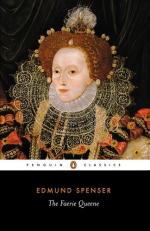III. STUDY OF THE FAERIE QUEENE
1. A ROMANTIC EPIC.—The Faerie Queene is the most perfect type which we have in English of the purely romantic poem. Four elements enter into its composition: “it is pastoral by association, chivalrous by temper, ethical by tendency, and allegorical by treatment” (Renton). Its subject was taken from the old cycle of Arthurian legends, which were brightened with the terrorless magic of Ariosto and Tasso. The scene of the adventures is laid in the enchanted forests and castles of the far away and unreal fairyland of mediaeval chivalry, and the incidents themselves are either highly improbable or frankly impossible. The language is frequently archaic and designedly unfamiliar. Much of the machinery and properties used in carrying on the story, such as speaking myrtles, magic mirrors, swords, rings, impenetrable armor, and healing fountains, is supernatural. All the characters—the knights, ladies, dwarfs, magicians, dragons, nymphs, satyrs, and giants—are the conventional figures of pastoral romance.
The framework of the plot of the Faerie Queene is vast and loosely put together. There are six main stories, or legends, and each contains several digressions and involved episodes. The plan of the entire work, which the author only half completed, is outlined in his letter to Sir Walter Raleigh. This letter serves as an admirable introduction to the poem, and should be read attentively by the student. Gloriana, the Queen of Fairyland, holds at her court a solemn feudal festival, lasting twelve days, during which she sends forth twelve of her greatest knights on as many separate adventures. The knights are commissioned to champion the cause of persons in distress and redress their wrongs. The ideal knight, Prince Arthur, is the central male figure of the poem. He is enamoured of Gloriana, having seen her in a wondrous vision, and is represented as journeying in quest of her. He appears in all of the legends at opportune moments to succor the knights when they are hard beset or in the power of their enemies. The six extant books contain respectively the legends of (I) the Knight of the Redcrosse, or Holiness, (II) Sir Guyon, the Knight of Temperance, (III) Britomart, the female Knight of Chastity, (IV) Sir Campbell and Sir Triamond, the Knights of Friendship, (V) Sir Artegall,




